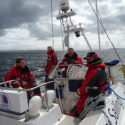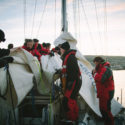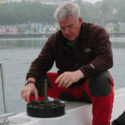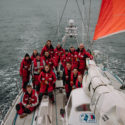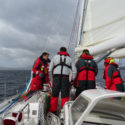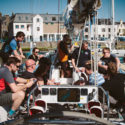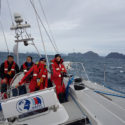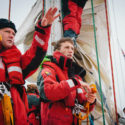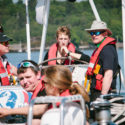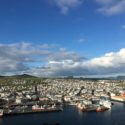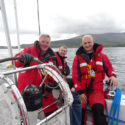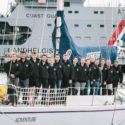On the 21st May 2017 a fifteen-strong crew, led by Maj Terry Hackett of London UOTC, began a two-week Adventure Training exercise onboard Yacht ‘Adventure’, one of the Army’s two Challenger 72’ Ocean going sail training yachts. The aim of Ex Artic Express was to challenge participants in a demanding environment and to develop their individual, and team skills.
Broken into three phases to enable the crew, many novice sailors, to become familiar with the vessel, the voyage consisted of:
Phase 1: Dunstaffanage Marina, Oban, to Stornaway, Isle of Lewis, in the Outer Hebrides of Scotland
Phase 2: Stornaway to Faroe Islands
Phase 3: Faroe Islands to Reykjavik, Iceland
The crew had to contend with a variety of conditions, including a Force 7 in the bleak North Atlantic, on minimal sleep in a very unforgiving environment. Ex Artic Express was a resounding success, enjoyed by all, and provided excellent development opportunities for all involved.
Phase 1 – Oban to Stornaway
All great adventures require some level of hardship. And the long and uncomfortable eleven-hour minibus trip to Scotland got Ex Artic Express off to a great start. When we finally arrived in the picturesque, and surprisingly busy, marina at Dunstaffanage the occupants exploded out of the cramped bus like shot from a cannon. Warmly greeted by the advanced party – our Skipper Maj Terry Hackett, 1st Mate WO2 Kelvyn Sauvary, and 2nd Mate OCdt Tom Simons – we were soon put to work.
Phase 1 proved to be the busiest, and physically hardest, part of the trip. Whilst we had a real mix of abilities and experience onboard, every member of the crew faced a steep learning curve. Not only did we have to quickly become familiar with the complex workings of a CH72, our new floating home, we also had to contend with living and working with each other in close confinement, in an ever-changing environment. It was literally ‘sink or swim’.
To ensure the boat was effectively managed 24 hours a day, the crew were split into three Watches: Red, White, and Blue. Each Watch would take turns to undertake the various tasks necessary to keep us in a ship shape and orderly fashion, whilst the others prepared meals or rested. In addition, individual crew members were allocated further responsibilities dependent upon their experience, including Sailmaker, Chief Engineer, Medic, and Bosun’s Assistant (QM) to name a few. Everyone was kept busy, and any notion we may have had that this was going to be an easy cruise were soon dashed.
By early Tuesday morning we were finally ready to slip our lines and our Skipper glided Yacht Adventure confidently out into the Sound of Mull, the channel separating the Isle of Mull from the mainland. All were excited as to what lay ahead, but none more so than OCdt Lauren Gault for whom it was her first time at sea.
Over the next few days all three watches were repeatedly drilled in numerous evolutions, including reefing the main (making the main sail smaller), changing the Yankee sail (reducing the size of the sail at the very front of the boat), and the one drill we hoped to never need – ‘Man Over Board’. Although hard work, with each iteration the Watches became more familiar with the necessary steps required to accomplish the task, and confidence grew.
By the end of the first day, after 8 hours of winching, grinding, and hauling, the crew were physically relieved to see the bright and colourful houses adorning Tobermory’s sea front slip into view. After a good night’s sleep the following day’s sail to Loch Harport was similarly exerting. Practise after practise, evolution after evolution, the miles slowly slipped away. Finally though, we slipped into the Loch; its steep flanks protecting us from the elements and providing a serene cruise to our evening’s resting place on the Isle of Skye.
With no deep-water pontoon available, the crew were given their first opportunity to drop the anchor. Under the careful instructions of the Skipper and 1st Mate, the plough shaped hunk of metal was released into the depths of the Loch, the chain rattling noisily across the deck like a crazed Halloween ghoul. Once the anchor was set, and all was calm, the Duty Watch were tasked with providing an ‘Anchor Watch’, to ensure the boat did not move in the night and to alert the Skipper to anything untoward.
Fortunately, nothing roused the Skipper, other than the phantom snorer, and after an 0400 start we were on our way to Stornoway, some 60 miles to the north. However, the day wasn’t to be without incident. Firstly, upon raising the anchor it became entangled around a mooring buoy, which required some considerable gymnastics from OCdt Tom Simons, the 2nd Mate. Climbing over the bow Tom stood on the anchor in the water, to release it. But released we were and we were soon underway.
To capture the quiet majesty of our stunning surrounding Sgt Ryan took the opportunity to capture the scenery on his Phantom Drone. Having taken off from the open deck, the drone was not more than six inches in the air, before it caught a line, flipped upside down, and dived over the rail into the Loch. Before anyone could react the very expensive professional aerial camera platform, which we were all so excited to have onboard, began its new career as an Autonomous Underwater Vehicle, now on its one-way mission to the bottom of a very deep Scottish Sea Loch.
Unsurprisingly, the rest of the crew learnt some enlightening Parachute Regiment terminology, as Sgt Ryan expressed his disdain and frustration at the sudden turn of events. Whilst much of the account is unrepeatable, it is to Sgt Ryan’s credit that, whilst understandably upset, he took the event in such good grace and we were pleased that his mood soon returned to the normal jovial and enthusiastic self.
As we cleared the Loch the wind vanished. Greeted by a wall of dense sea fog, we had no choice but be engulfed within its thick cotton wool interior. Whilst we finally broke free from its clutches later that afternoon, the wind did not return and we had to endure the monotony of motor sailing (where sails and the inboard diesel engine were used in combination) for the final leg to Stornoway. Our spirits were lifted when we were joined by several pods of Common dolphins, as well as smaller Harbour Porpoises, which playfully chased the boat. With the first training phase complete, we were ready for Phase 2, a three day ocean passage to the Faroe Islands, however without any wind it was to prove quite uneventful.
Phase 2 – Stornoway to Faroes
After a relaxed 0700 start the crew’s main goal, after having to clean the boat, was exploring Stornoway in search of a decent cup of coffee. Mission completed and given the wind had failed to materialise we slipped out in the North Atlantic on a caffeine high, quickly slipping into the routine of the 3 Watch system. Each watch lasted 4 hours, and we took it in turns to be either ‘Duty Watch’ or ‘On Watch’ (responsible for sailing the boat and keeping the Ship’s Log), or ‘Off Watch’ (asleep) for 48 hours, until it was your turn to be ‘Mother Watch’ (which involved preparing all the meals, refreshments, and generally keeping the boat clean) and importantly afforded you 24 hours rest. This meant over the three days all three Watches rolled through the system, and were all equally as shattered.
As we slowly crept North to the Faroes, apart from occasional sail alterations or minor course corrections, the hours crawled by. Being ‘on Watch’ was pleasant given the weather was so mild, and the sea so calm, but more importantly you could escape the loud drone of the engine below. Being so far north it never actually got dark. Our bodies became confused, and increasingly more tired, unsure whether they were supposed to be awake or asleep. When stood down there was a sense of urgency amongst the weary crew in order to maximise the four hours’ sleep afforded to you. To pass the hours we searched for varied and vaguely interesting topics to discuss as a means of staying awake, a luxury not typically afforded to those on ‘Stag’. Our handovers became quite perfunctory, with nothing more than a sleepy nod, and “a nothing to report since you were last here” response. We all longed to see Dolphins and Whales, but none would break the tranquillity.
Eventually in the early hours of the third day at sea, the dark shadow of the Faroe Islands loomed on the horizon, like a sleeping giant laying in ambush. By mid-morning we were passing the steep rocky shores of the Southern archipelago, clearly able to identify small settlements nestled in nooks and inlets of the mountainous terrain. As we steadily made our way to the Faroes capital Torshaven, lying to the North of the islands, we could only wonder at what kind of lifestyle these remote inhabitants must lead out here in the middle of the North Atlantic. Yacht Adventure finally crept between the islands which afforded Torshaven some protection from the violent assaults launched by the North Atlantic. Gaining our first glimpse of the Faroes capital, we breathed a sigh of relief that we had escaped its fury and could relax till tomorrow.
The town crowded the waterfront and covered the surrounding hills like a glacier; stretching down from craggy mountain tops overlooking the bay to the seashore. Colourful turf clad houses nestled near the water’s edge like jittery antelopes around a waterhole, whilst large industrial units stood sullenly in the background. Bright traditional fisherman’s huts that hinted to the port’s fishing heritage stood alongside modern apartments and hotels filling any remaining space. Yachts and small fishing boats bobbed in the marina to our left, whilst a large container ship, Torshaven’s lifeline with the mainland, loomed ominously to our right like a sulking behemoth.
Having been at sea for three days the crew were unsurprisingly keen to get ashore and enjoy a short stop-over in Torshaven. This surprisingly vibrant town, home to 50,500 people and 14,500 sheep, proved very accommodating.
Phase 3 – Faroe Islands to Reykjavik
The following evening as we left the Faroe Islands behind us the wind finally began to strengthen, filling our sails with strengthening resolve as it propelled us along with a renewed sense of urgency, the boat lurching and thumping against a restless sea. Any doubts we had as to the power of the North Atlantic quickly vanished. The beast had awoken and it made it very clear who was in charge. Yacht Adventure is a very capable boat and has endured much worse than this, but as the waves towered over us, breaking around us like swarms of giant angry wasps, we felt like a child’s toy at bath time. This was Adventurous Training. This is what we had signed up for.
The two day passage to the little fishing port Vestmannaeyjar, on a volcanic island just south of Iceland, passed in a blur. Everyone had exciting stories to tell when we were finally able to venture ashore. Sail changes in the dead of night. Waves crashing over the bow, swamping the deck. Crew members engulfed in icy waters. But we all shared one tale: how little sleep we had achieved given the boat’s persistent pitching and crashing as it fought the rough seas. As the crew took the opportunity to relax in the local swimming pool, enjoying the hot thermal pools, water slides, and showers, little did we know what was waiting for us during our final leg.
The wind was steadily increasing and during the final 24 hours of Sailing from Vestmannaeyjar to Reykjavik we were to encounter a cheeky Force 7. Once we had slipped from refuge of port, turning North-North East for the final run home, even hoisting the sails became immensely challenging. It was clear we were in for a rough ride. All through the night the ‘On Watch’ were required to change sails and reef the main several times – no easy task in heavy seas. But the crew did well, with training from Phase 1 now paying off, and the time taken to complete each evolution dramatically reduced. It truly was a memorable experience: real Adventurous training.
Once safely in Reykjavik the exhilaration of the past few days kept us enthused as we began the gargantuan task of deep cleaning a 72’ foot boat. A well organised tour by OCdt Whitehouse enabled the crew to relax and enjoy the local highlights of the Land of Fire and Ice, whilst high foreign exchange rates ensured the post-exercise Team meal didn’t become overly exuberant, with many of the crew to be found snoring in their bunks well before any reasonable student should be home.
Ex Arctic Express challenged all participants, providing a dramatic and demanding environment which successfully developed individual sailing skills, as well as providing plentiful opportunity to develop team and leadership skills. The expedition was acknowledged by all to be a resounding success.
LCpl Ben Spurway
Watch Leader White Watch

